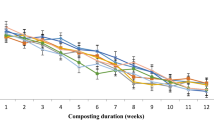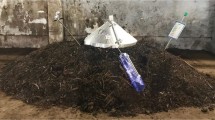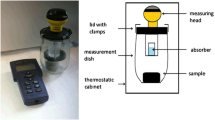Abstract
The effect of two abundant, easily available and very low-cost agro-industrial organic residues, i.e., filter cake from the sugar industry and poultry litter, on the composting stabilization time of coffee pulp and on the quality of the produced compost, was evaluated. Piles of one cubic meter were built and monitored within the facilities of a coffee processing plant in the Coatepec region of the State of Veracruz, Mexico. Manual aeration was carried out once a week. A longer thermophilic period (28 days) and a much lower C/N ratio (in the range of 6.9–9.1) were observed in the piles containing the amendments, as compared to the control pile containing only coffee pulp (14 days and a C/N ratio of 14.4, respectively). The maximum assimilation rate of the reducing sugars was 1.6 g kg-1 d-1 (from 7.5 to 5.3%) during the first two weeks when accelerators were present in the proportion of 20% filter cake plus 20% poultry litter, while they accumulated at a rate of 1.2 g kg-1 d-1 (from 7.4 to 9.13%) during the same period in the control pile. The best combination of amendments was 30% filter cake with 20% poultry litter, resulting in a final nitrogen content as high as 4.81%. The second best combination was 20% filter cake with 10% poultry litter, resulting in a compost which also contained a high level of total nitrogen (4.54%). It was concluded that the use of these two residues enhanced the composting process of coffee pulp, promoting a shorter stabilization period and yielding a higher quality of compost.
Similar content being viewed by others
References
Allison LE (1965) Organic carbon. In: Black CA et al. (Eds) Methods of Soil Analysis. Part 2 (pp 1367–1378). American Society of Agronomy, Inc., Publisher Madison, WI, USA
Anderson J & Smith J (1987) Composting. In: Sidwick J & Holdom R (Eds) Biotechnology of Waste Treatment and Exploitation (pp 301–325). Ellis Horwood Limited, Chichester West Sussex, England
Atallah T, Andreux F, Choné T & Gras F (1995) Effect of storage and composting on the properties and degradability of cattle manure. Agr. Ecosyst. Environ. 54: 203–213
Brink N (1995) Composting of food waste and catching nitrogen. Acta. Agric. Scand. B Soil Plant Sci. 43: 114–120
Calzada F, García R, Porres C & Rolz C (1989) Integrated utilization of coffee processing by-products and wastes. In: Wise D (Ed) International Biosystems, Vol II (pp 41–51). CRC Press, Boca Raton, USA
Canet R & Pomares F (1995) Changes in physical, chemical and physico-chemical parameters during the composting of municipal solid waste in two plants in Valencia. Biores. Technol. 51: 259–264
Crawford JH (1983) Composting of agricultural wastes — A Review. Process Biochem. January/February: 14–18
Crawford J (1985) Composting of agricultural wastes. In: Cheremisinoff P & Ouellette R (Eds) Biotechnology Applications and Research (pp 68–77). Technomic Publishing Co, Inc., Lancaster, Pennsylvania, USA
Dabyshire JF, Davidson MS, Gaskin GJ & Campell CD (1989) Forced aeration composting of composting bark. Biol. Waste 30: 275–287
Fernández F, Pierro A & Yamamoto Y (1993) Producao de fertilizante organico compostagem do lodo generado por estacoes de tratamento de esgotos. Pesq. Agropec. bras 28(5): 567–574
Furman NH (1975) Standard Methods of Chemical Analysis. Krieger, Huntington, NY
Golueke C (1977) Biological Reclamation of Solid Waste. Rodale Press, Emmaus, PA
Iglesias E & Pérez V (1991) Composting of domestic refuse and sewage sludge. I. Evolution of temperature, pH, C/N ratio and cation-exchange capacity. Resour. Conserv. Recycl. 6: 45–60
Inbar Y, Chen Y, Hadar, Y & Hoitink HAJ (1990) New approaches to compost maturity. Biocycle 31(12): 64–68
Miller GL (1959) Use of dinitrosalicylic acid reagent for determination of reducing sugars. Anal. Chem. 3: 426–428
Murillo JM, Cabrera F, López R & Martín-Olmedo P (1995) Testing low-quality urban composts for agriculture: germination and seedling performance of plants. Agr. Ecosyst. Environ. 54: 127–135
Olguín EJ, Sánchez G & González R (1993) Accelerated food waste composting. World J. Microb. Biot 9: 625–629
Olguín EJ, Doelle HW & Mercado G (1995) Resource recovery through recycling of sugar processing by-products and residuals. Resour. Conserv. Recycl. 15: 85–94
Olguín EJ (1996) Current status and potential of environmental biotechnology in Mexico. In: Moo-Young M et al. (Eds) Environmental Biotechnology: Principles and Applications (pp 723–734). Kluwer Academic Publishers, Dordrecht/Boston/London
Pessarakli M (1990) Composting gin trash reduces waste disposal and pollution problems. J. Environ. Sci. Health A25 8: 1037–1047
Rodrígues AM, Ferreira LJ, Fernando AL, Urbano P & Santos-Oliveira J (1995) Co-composting of sweet sorghum biomass with different nitrogen sources. Biores. Technol. 54: 21–27
Sánchez G (1997) Compostaje acelerado de pulpa de café a nivel semipiloto y piloto. Tesis, Instituto Tecnológico de Veracruz, Veracruz, México
Schwab BS, Ritchie CJ, Kain DJ, Dobrin GC, Lawrence WK & Palmisano AC (1994) Characterization of compost from a pilot plant-scale composter utilizing simulated solid waste. Waste Manage. Res. 12: 289–303
Tauk S, Lucato V & Derigi J (1982) Factors affecting composting of instant coffee residue with and without the utilization of inocula. Environ. Technol. 3: 173–178
Author information
Authors and Affiliations
Rights and permissions
About this article
Cite this article
Sánchez, G., Olguín, E.J. & Mercado, G. Accelerated coffee pulp composting. Biodegradation 10, 35–41 (1999). https://doi.org/10.1023/A:1008340303142
Issue Date:
DOI: https://doi.org/10.1023/A:1008340303142




